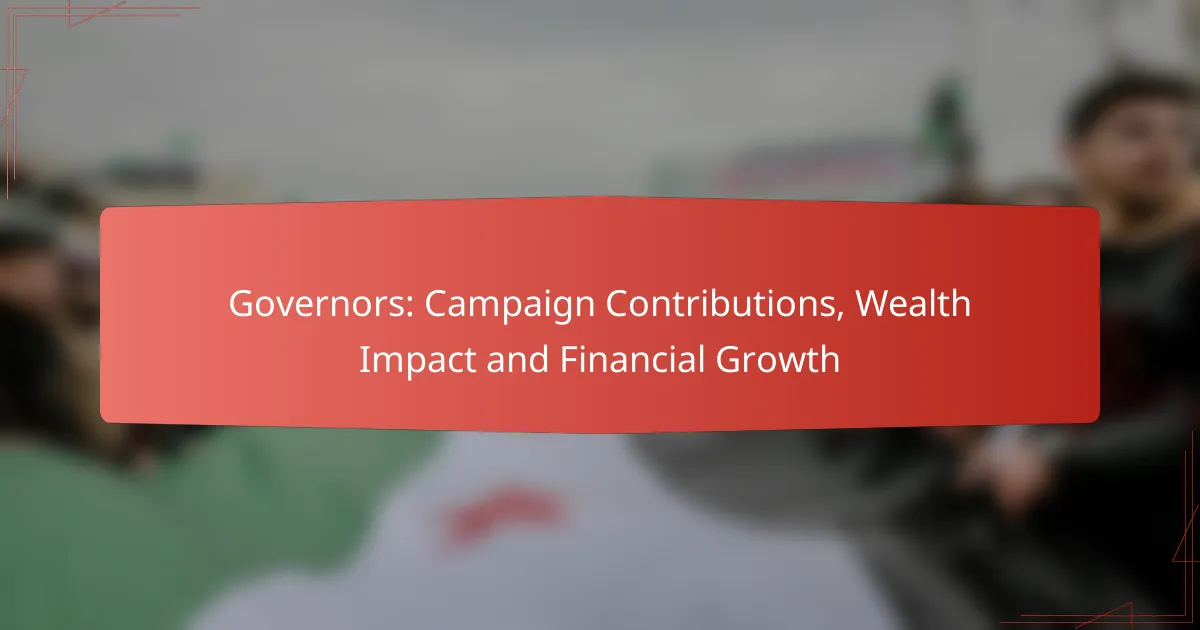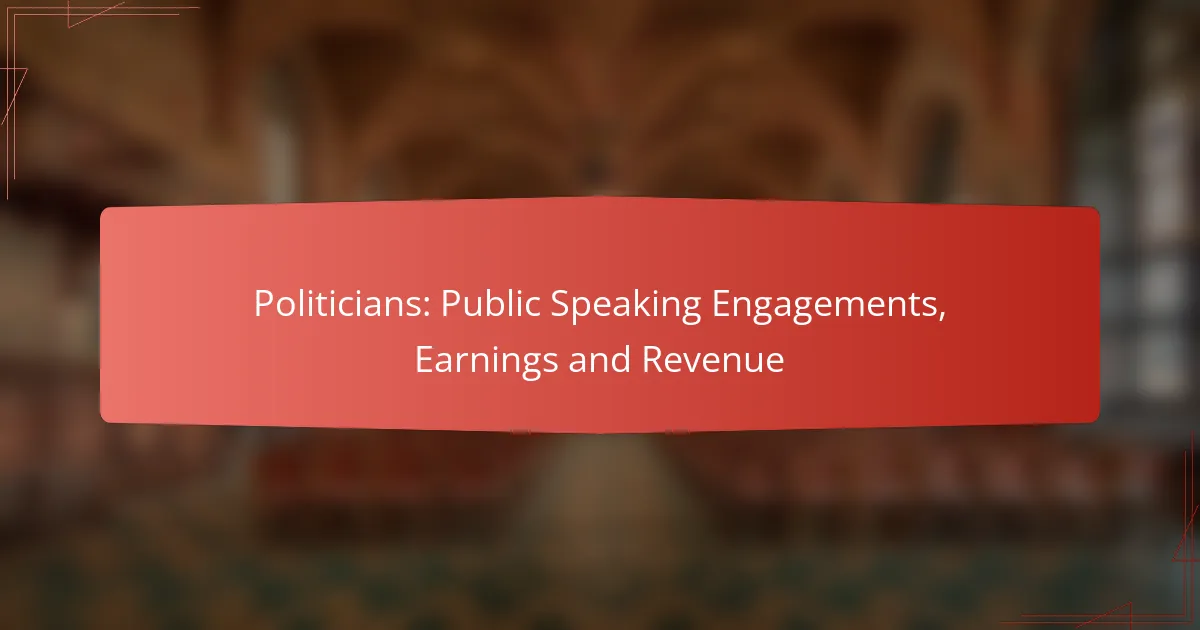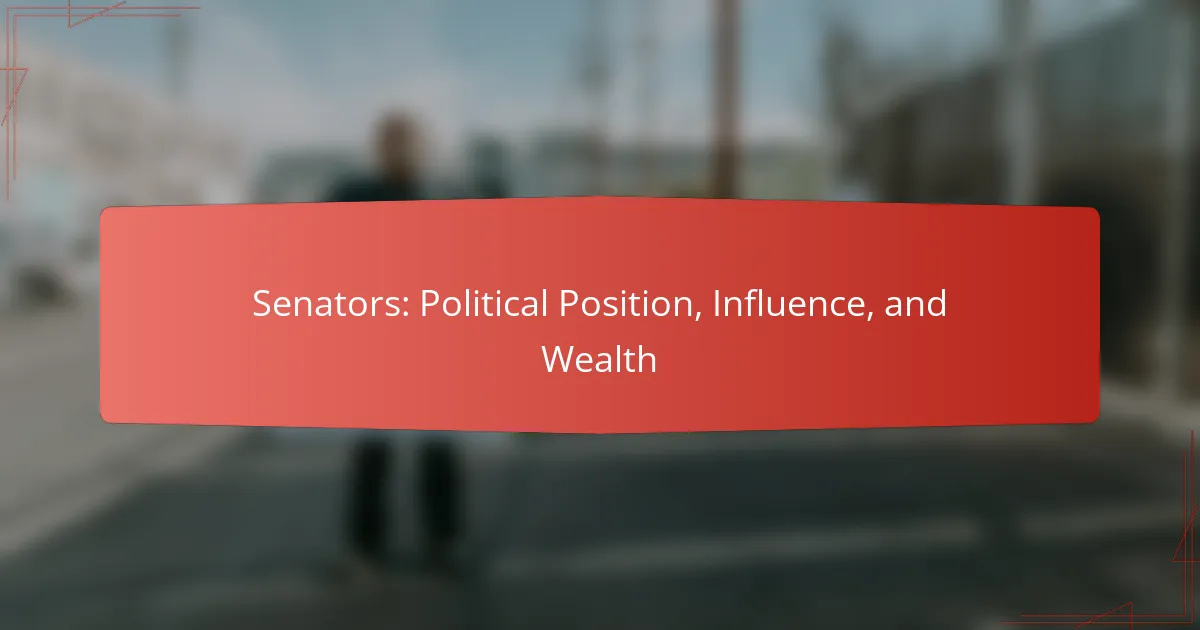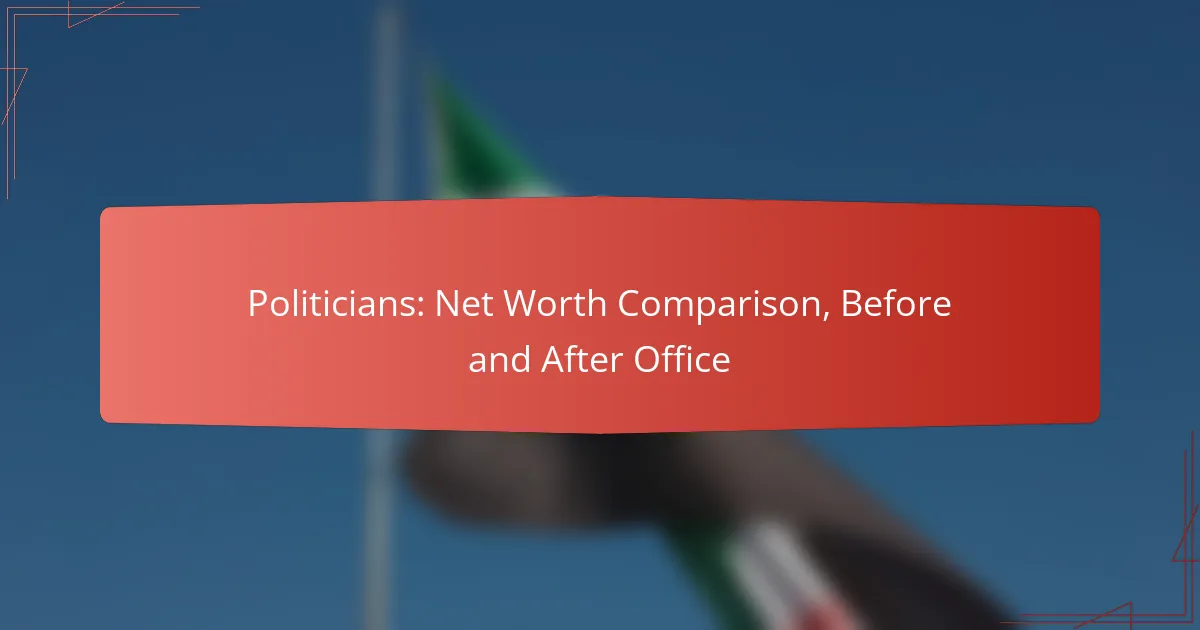Campaign contributions play a crucial role in shaping the financial landscape for governors, often leading to increased personal wealth through various lucrative opportunities. These contributions, sourced from individual donors, political action committees, and corporations, not only fund campaigns but can also influence policy decisions and governance priorities, creating a complex interplay between financial support and political action.

How do campaign contributions affect governors’ wealth in the United States?
Campaign contributions can significantly influence governors’ personal wealth, as they often lead to lucrative opportunities and connections. The financial support received during campaigns may translate into increased income through various channels, including consulting roles, speaking engagements, and business ventures.
Direct correlation with personal wealth
There is a notable correlation between campaign contributions and the personal wealth of governors. Wealthy donors often expect favorable policies in return for their financial support, which can lead to increased income for governors post-election. This relationship can create a cycle where financial success in politics encourages further contributions.
For example, governors who receive substantial campaign funding may find themselves in high-demand for advisory roles or board positions after their terms, further enhancing their financial status.
Impact on fundraising success
Campaign contributions can significantly boost a governor’s fundraising success. A well-funded campaign can attract more donations, as potential contributors often perceive financial backing as a sign of viability and influence. This can create a snowball effect, where initial contributions lead to more significant support from other donors.
Governors who demonstrate strong fundraising capabilities are often viewed as more competitive, which can enhance their political capital and lead to additional funding opportunities.
State-specific examples
In states like California and Texas, governors have seen their wealth increase substantially due to high levels of campaign contributions. For instance, California’s governor has leveraged contributions to secure lucrative speaking engagements and consulting roles, significantly boosting personal income.
Conversely, in smaller states with less campaign funding, governors may not experience the same level of financial growth, highlighting how the impact of contributions can vary widely based on state dynamics and donor landscapes.
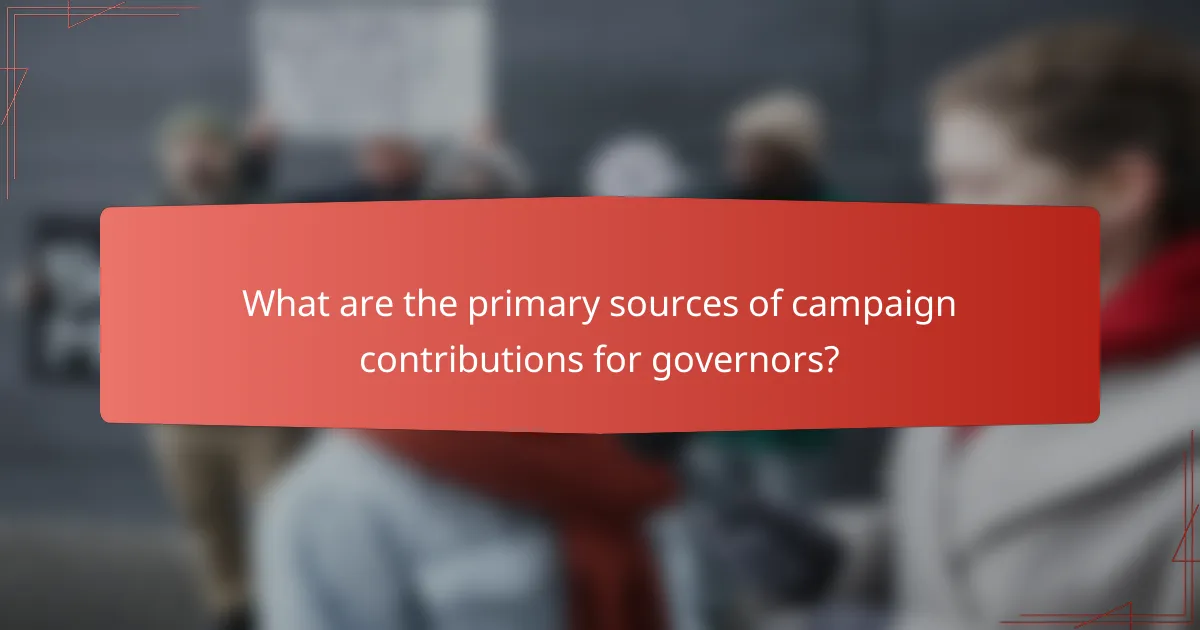
What are the primary sources of campaign contributions for governors?
The primary sources of campaign contributions for governors include individual donors, political action committees (PACs), and corporate contributions. Each source plays a significant role in shaping a governor’s campaign financing strategy and can influence their policy decisions.
Individual donors
Individual donors are often the backbone of campaign contributions, providing funds directly to candidates. These contributions can range from small amounts from grassroots supporters to larger sums from wealthy individuals. Many states have contribution limits for individual donors, which can affect how much a candidate can raise from this source.
Campaigns typically engage individual donors through fundraising events, online donations, and direct outreach. Building a strong network of individual supporters can lead to sustained financial backing throughout a campaign cycle.
Political action committees (PACs)
Political action committees (PACs) are organizations that collect and distribute contributions to candidates, often representing specific interest groups or industries. PACs can provide substantial funding, sometimes reaching into the hundreds of thousands of dollars for a single campaign. They are particularly influential in shaping policy agendas aligned with their interests.
Governors often seek PAC contributions to bolster their campaign finances, but they must navigate regulations that govern how much PACs can donate. Understanding the landscape of PACs relevant to a campaign can help candidates strategically target their fundraising efforts.
Corporate contributions
Corporate contributions come from businesses and organizations that support candidates whose policies align with their interests. These contributions can significantly impact a campaign’s financial resources, especially in competitive races. However, many jurisdictions have specific regulations regarding corporate donations, including limits and disclosure requirements.
Governors may cultivate relationships with corporate donors through networking and events, but they must be cautious of potential conflicts of interest. Transparency in corporate contributions is crucial to maintaining public trust and ensuring compliance with campaign finance laws.
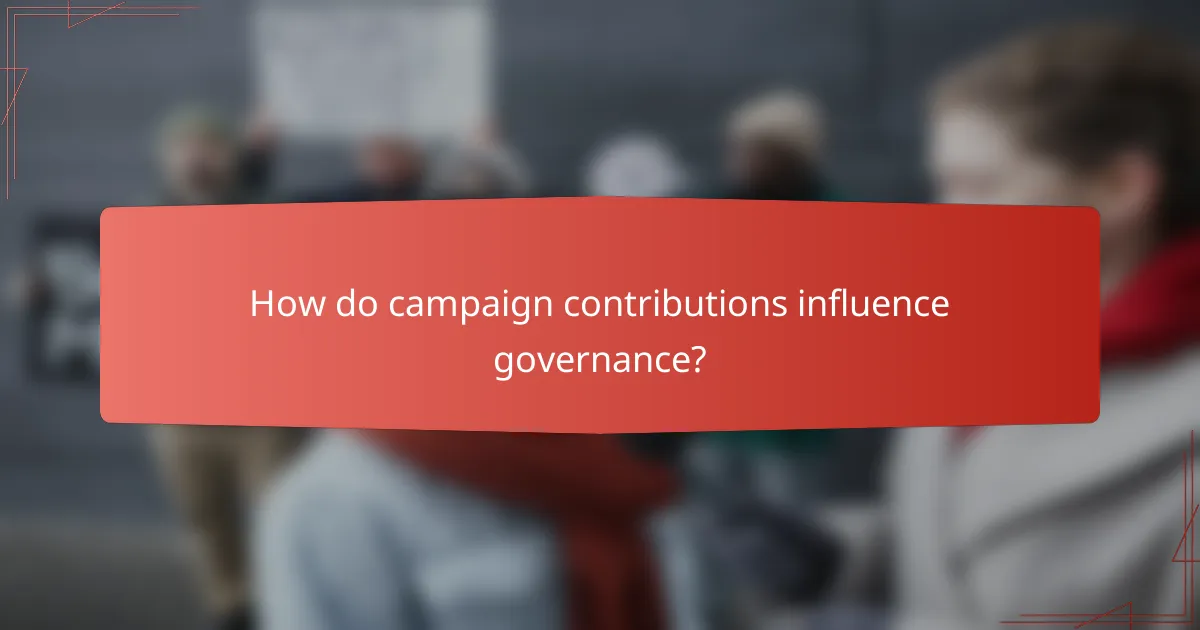
How do campaign contributions influence governance?
Campaign contributions significantly impact governance by shaping the priorities and actions of elected officials. When politicians receive funding from specific donors, they may feel compelled to align their policy decisions with the interests of those contributors.
Policy decisions favoring donors
Governors often make policy decisions that reflect the interests of their major donors. For instance, if a corporation contributes heavily to a campaign, the governor may prioritize legislation that benefits that industry, such as tax breaks or regulatory leniency. This can lead to a governance style that favors wealthy contributors over the general public.
Moreover, the perception of favoritism can undermine public trust in government. Citizens may feel that their needs are secondary to those of affluent donors, which can result in decreased civic engagement and voter turnout.
Legislative priorities shaped by funding
Funding influences legislative priorities by directing attention and resources toward issues that matter to donors. For example, if a significant portion of contributions comes from environmental groups, a governor may prioritize green energy initiatives. Conversely, contributions from the fossil fuel industry might lead to policies that support traditional energy sources.
Governors must balance these competing interests, but the pressure from major contributors can skew priorities. It’s essential for voters to be aware of these dynamics, as they can affect the overall direction of state policies and the allocation of public resources.

What are the trends in campaign contributions for governors?
Campaign contributions for governors have seen significant changes in recent years, with notable increases in small donor contributions and a marked shift towards online fundraising. These trends reflect evolving donor behaviors and the increasing importance of grassroots support in gubernatorial campaigns.
Increase in small donor contributions
Small donor contributions have become a vital source of funding for gubernatorial campaigns, often driven by grassroots movements and increased engagement from the electorate. Many campaigns now actively encourage contributions from individuals, typically ranging from $5 to $100, to build a broad base of support.
This trend is supported by various matching fund programs in states like New York and California, where small donations can be matched at higher rates, amplifying their impact. Candidates who effectively mobilize small donors often find themselves with a more committed supporter base, which can lead to increased volunteer efforts and voter turnout.
Shift towards online fundraising
Online fundraising has transformed how gubernatorial candidates raise money, allowing for quicker and more efficient collection of contributions. Platforms like ActBlue and WinRed have made it easier for candidates to reach potential donors through social media and email campaigns, often resulting in higher overall contributions.
Many campaigns now allocate significant resources to digital marketing strategies, leveraging data analytics to target specific demographics. This shift not only broadens the reach of fundraising efforts but also allows for real-time adjustments based on donor responses, maximizing the effectiveness of each campaign dollar spent.

How do governors’ financial growth metrics compare post-election?
Governors often experience significant financial growth after their time in office, influenced by various factors including campaign contributions and investment opportunities. This growth can vary widely based on individual circumstances, state regulations, and personal financial strategies.
Average net worth increase
On average, governors may see their net worth increase by a substantial margin after leaving office, often ranging from hundreds of thousands to several million dollars. This increase is typically driven by lucrative speaking engagements, book deals, and other post-office opportunities.
Factors such as the governor’s previous financial status, the state’s economic conditions, and the political climate can all impact the extent of this financial growth. For example, governors from states with robust economies may experience higher net worth increases compared to those from states facing economic challenges.
Investment strategies post-office
Many governors adopt diverse investment strategies after their tenure, focusing on real estate, stocks, or starting their own businesses. These strategies are often influenced by their previous experiences and the connections they established while in office.
Common pitfalls include overextending financially or investing in high-risk ventures without adequate research. A balanced approach, such as diversifying investments and consulting financial advisors, can help mitigate risks and enhance financial stability in the long term.

What are the implications of wealth on governors’ political careers?
Wealth can significantly influence governors’ political careers, impacting their ability to fund campaigns and shape public perception. A governor’s financial resources often correlate with their re-election chances and the trust they command from constituents.
Influence on re-election prospects
Wealthy governors typically have an advantage in securing campaign contributions, which can enhance their visibility and outreach efforts. This financial backing allows for more extensive advertising, grassroots initiatives, and engagement with voters, all of which can improve re-election prospects.
For instance, a governor with access to substantial personal wealth or affluent donors may spend millions on their campaign, while others might struggle to raise sufficient funds. This disparity can create a significant gap in competitiveness during elections.
Public perception and trust
The financial status of governors can shape public perception, influencing how voters view their integrity and priorities. Wealthy governors may be perceived as out of touch with average citizens, which can erode trust and support.
Conversely, governors who demonstrate a commitment to public service over personal gain can foster a positive image, even if they possess considerable wealth. Transparency in financial dealings and a focus on community issues can help mitigate negative perceptions associated with wealth.

How do campaign finance laws vary across states?
Campaign finance laws differ significantly from state to state, affecting how much individuals and organizations can contribute to political campaigns. These variations can impact the overall financial landscape of gubernatorial races, influencing candidate strategies and voter engagement.
State-specific contribution limits
Each state sets its own contribution limits for campaign financing, which can vary widely. For example, some states may allow contributions in the range of a few hundred dollars per individual, while others may permit thousands. These limits can apply to different types of contributors, including individuals, political action committees (PACs), and corporations.
Understanding these limits is crucial for candidates and donors alike. In states with lower contribution limits, candidates may need to engage more with a larger number of small donors, while those in states with higher limits might focus on fewer, larger contributions. This can shape campaign strategies and outreach efforts significantly.
Additionally, some states have different rules for primary and general elections, which can further complicate fundraising efforts. Candidates should familiarize themselves with their state’s specific regulations to ensure compliance and optimize their fundraising strategies.
